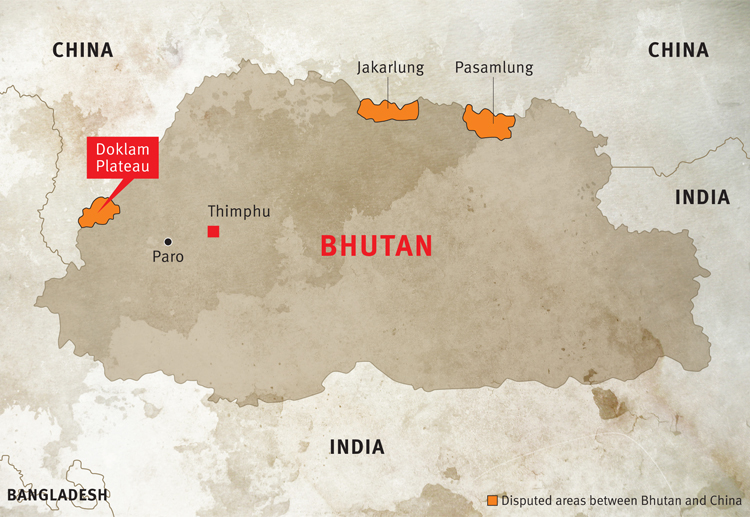INDIAN ARMED FORCES CHIEFS ON
OUR RELENTLESS AND FOCUSED PUBLISHING EFFORTS

SP Guide Publications puts forth a well compiled articulation of issues, pursuits and accomplishments of the Indian Army, over the years

I am confident that SP Guide Publications would continue to inform, inspire and influence.

My compliments to SP Guide Publications for informative and credible reportage on contemporary aerospace issues over the past six decades.
- Interim Defence Budget 2024-25 — An Analysis
- Union Defence budget 2024
- Indian Army: In quest of greater firepower and policy recommendations for gaps
- Indian Army Annual Press Conference 2024
- 6G will transform military-industrial applications
- Tata Boeing Aerospace Delivers 250 AH-64 Apache Fuselages, Manufactured in India
The Doklam Standoff
 |
By Lt. General V.K. Kapoor (Retd) |

In all cases of boundary disputes between two countries, the sticking points evolve on the basis of historical records and differing perceptions of the boundary lines because of the inaccuracies of the old surveys and/or the mental conditionings of the people in each country, which are actually conditioned by the emotions and rhetoric of the hierarchy/leadership of each country more than by rational analysis. Hence, in the absence of proper delineation of the boundary on the ground, each country tries to interpret the boundary from its own stand point which would give it an advantage over the other country.
Historical Backdrop
With regard to the issue on hand – the China-India-Bhutan tri-junction -there certainly are differences. Both India and Bhutan put the tri-junction near Batang La (N 27°19'48" & E 88°55'04"). A record of the 68th session of the Bhutanese National Assembly in 1989 noted that the border would go from Batang La to Merugla to Sinchela along the ridge and then down to Amo Chhu river.
The Chinese, however, insist that the tri-junction is at Mount Gipmochi as mentioned in an article by an Indian defence analyst. As the Chinese spokesman noted on July 5, "the 1890 convention stipulates that the Sikkim section of the China-India boundary commences at Mount Gipmochi." Then there is the problem of locating Gipmochi. An 1861 British map shows Gipmochi near the tri-junction but within Bhutan. Many old maps show the beginning of the border from a place called Gyemochen. Indeed, the Bhutanese themselves noted, as the records of the 82nd session of their National Assembly reveal that "the Chinese had been going from Gyemochen and Chela to Amo Chhu. "A modern data base, the one created and maintained by the US shows Gipmochi/Gyemochen to be at least 5 kms east of where the earlier Gipmochi/Gymochen are designated."
The issue commenced On June 29, when Bhutan put out its press release noting that on June 16th, "the Chinese Army started constructing a motorable road from Dokola in the Doklam area towards the Bhutan Army camp at Zompelri. Boundary talks are ongoing between Bhutan and China and we have written agreements of 1988 and 1998 stating that the two sides agree to maintain... status quo on the boundary as before March 1959."
This amounted to a violation by the Chinese of their 1998 agreement with Bhutan by which status quo as of 1959 was to be maintained. This was earlier violated by the Chinese by building a motorable track to a point below Doka La which is some 2 kms north of Gymochen.
India's Assertiveness
India has been, for a change, rather assertive about protecting its strategic vital interests in the region because of the nearness of its vital areas of interest which would be compromised by China extending its reach in the Doklam plateau. However while looking after its strategic vital interest in the sector, India also needs to have a clear vision regarding the manner in which the cartographic game will be played out and take care to protect interests in this sphere of activity as well. MEA must consult the Indian Army before making any commitments on maps because the army is located on the ground and is more knowledgeable about the exact locations of the landmarks which may be located differently on old maps due to cartographic errors.
Lt General DS Hooda, the former Army Commander of Northern Command, gives another angle to this issue. He says, "The Doklam stand-off was inevitable. It may be resolved peacefully but it is a manifestation of the larger geopolitical contest that is playing out in Asia between India and China. How do we respond? Economically, it is a no-contest because it is only in 2030 that India will reach the size of China's 2014 GDP. Perhaps the answers lie in geography. Expanding from its peripheries, China has economically secured its borders." He then goes on to explain how China has secured its land borders through trade and investment with various countries along its borders. This is reflected in the shift in China's strategy to also encompass "far seas" protection in addition to "near sea" defence. The primary "far sea" is the Indian Ocean, across which flow not only Chinese oil but also raw materials sourced from Sub-Saharan Africa. He thus contends that "India is also constrained by geography. It is hemmed in from the north by the Himalayas and the west by a hostile Pakistan. East and south are the only natural gateways and that should dictate our strategy." Therefore he suggests that we push the "Act East Policy" which also lacks credibility due to our inability to complete the projects undertaken, in time, which does not inspire confidence in our abilities.
Notwithstanding our weak performances in executing projects, it is felt that gradually rising anti-China sentiment will "willy nilly" force us into a position of leadership in South Asia and South East Asia but if we are not physically or mentally strong enough to face the situation which is arising out of China's domination and expansionist tendencies, we are likely to be humiliated and embarrassed in the future.
China's Warnings-A Regular Occurrence
In the meanwhile the Doklam stand-off is getting more and shriller as far as the Chinese media is concerned. The Chinese Foreign Ministry has through the state run Global Times, on10 August warned that "India should withdraw its troops and equipment. Regardless of how many Indian troops have trespassed into and stayed in Chinese territory, they have gravely infringed on China's sovereignty." Such warnings have been a regular occurrence in the Chinese media since the stand-off commenced nearly 9 weeks ago.
China Daily, in one of its most scathing editorials on Wednesday, 09 August, 2017, warned that 'the countdown to a clash between the two forces has begun'. The editorial titled 'New Delhi should come to its senses while it has time', suggested that the window to peacefully resolve the stand-off in Doklam is closing. "The countdown to a clash between the two forces has begun, and the clock is ticking away the time to what seems to be an inevitable conclusion."
This has led many analysts to believe that a skirmish may develop in the tri-junction area of Sikkim. From the media reports it seems both the armies have increased their presence near the site. There is news regarding China having increased its strength by one more battalion sized group in the area while India it seems is consolidating its defences all along the Line of Actual Control with China, starting from Ladakh Region in the North to the Eastern Theatre including Sikkim, Bhutan and Arunachal just to be on the safe side. Reserves should be positioned wherever necessary in the form Operational Alerts and exercises in the entire region which is an yearly ritual in any case.
What should be India's Future Strategy
Uday Mahurkar in his fascinating new book, Marching with a Billion: Analysing Narendra Modi's Government at Midterm says, 'Modi's China diplomacy signals a great change in India's attitude towards that nation -- from a defensive posture maintained over several decades to that of equal, controlled aggression.'
According to Daniel Twining, a foreign policy expert and director for Asia at the German Marshall Fund of the US, Modi is making all the right moves in the diplomatic arena, including in developing the India-US relationship vis-à-vis China. As he puts it, "Modi is demonstrating the right vision against the backdrop of the emerging Chinese hegemony, the Russian stance and the growing terror threat."
"India and the US together can be great pace-setters. But to realise India's full potential in the international arena and against China, Modi has to raise India's woefully low defence spending of around 1.62 per cent of its GDP and take it at least beyond 2 per cent at a time when countries like the US spend 4 per cent on defence."
The fact is that India's defence spending is inadequate to even maintain the current force levels and make up its shortfalls and deficiencies and therefore if we have to modernize and build new capabilities to be able to stand up to the emerging hybrid threats and challenges including the collusive China - Pakistan threat, state sponsored terrorism by Pakistan and home grown insurgencies and internal situations requiring military interventions, the nation would have to allocate up to 3 percent of its GDP towards defence instead of the current allocations amounting to less than 2 percent.
At Dokalam, having adopted a stance of protecting its vital national interests, India cannot afford to back down and therefore it needs to ramp up its diplomatic activity in garnering world opinion in its favour and in making up the deficiencies and shortfalls in the military.
Militarily we need to raise our operational alertness status all along the LAC, in the air, and in the maritime sphere by appropriate positioning of reserves so as to meet, all threats and challenges on land, sea and air in the near future. For the long term we need speed up the capability building process to meet future threats more offensively and aggressively. Against China we cannot afford to show any complacency.





